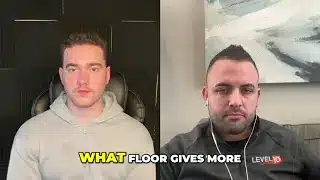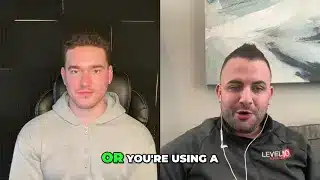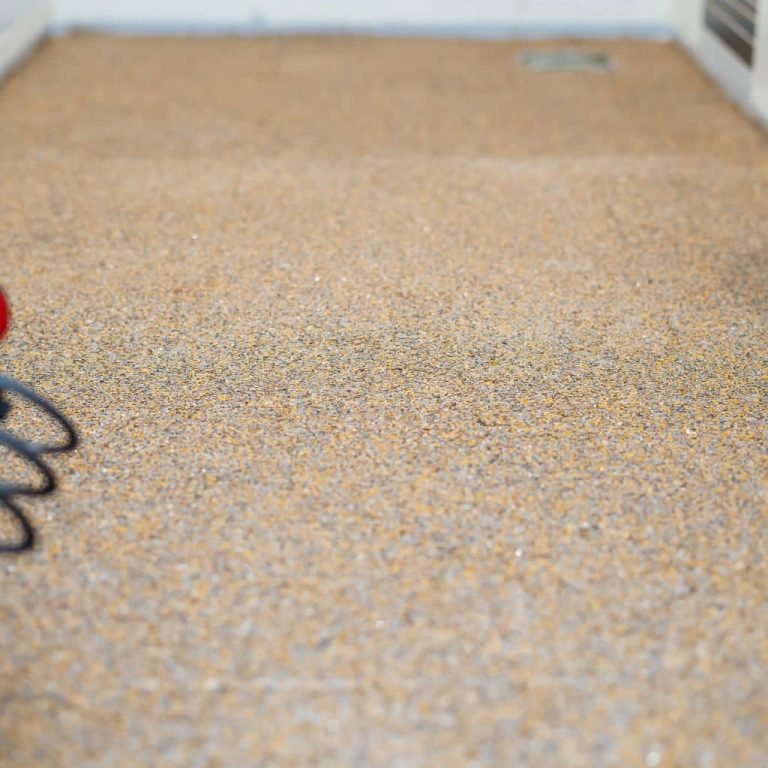When it comes to home improvement, people often focus on kitchens, bathrooms, and curb appeal as prime areas to boost property value. But one upgrade is steadily gaining attention among homebuyers and real estate professionals: a well-coated garage floor. Specifically, a polyurea garage floor coating can protect your concrete, improve your garage’s aesthetics, and, in certain circumstances, even enhance your home’s resale value.
In a recent interview, concrete-coating specialist Crayton Caudill from Level 10 Coatings shed some light on the relationship between a polyurea-coated garage floor and the overall value of your property. He noted that such an improvement “certainly can increase your home value up to 20 or 25 percent of the investment you make”—though the actual benefit depends on factors like the age of your home, the condition of the concrete, and whether prospective buyers value a well-finished garage.
This article digs deeper into how a polyurea garage floor can affect resale value, the conditions under which the boost is most noticeable, and the ways this technology protects your property investment.
Why Garage Floors Matter More Than You Think
Many potential buyers judge a house from the moment they pull into the driveway. If your garage door is open—or if your realtor shows prospective buyers the garage in a walkthrough—it sets the tone. A dirty, cracked, or stained garage floor can suggest poor maintenance overall. On the other hand, a meticulously coated, polished surface signals pride in ownership.
Perception vs. Reality
A house may be structurally sound, but if buyers see major cracks or large stains on the concrete, they often assume the worst. They might suspect foundation problems or wonder whether they’ll need to spend thousands (even tens of thousands) on repairs. Some might see it as a red flag—turning down an offer or deciding not to place one in the first place.
Conversely, a well-coated garage floor immediately conveys that:
- The space has been well-maintained.
- Any underlying issues have likely been addressed.
- The homeowner invests in quality features and upkeep.
Increasingly Popular Spaces
Today’s garages aren’t just for storing cars and shovels. Many people turn them into hobby workshops, home gyms, craft areas, or even showrooms for prized vehicles. These “livable garage” trends have pushed more homeowners to look for higher-end flooring solutions. Consequently, future buyers often see a coated garage floor as a major plus—especially if they’ve long dreamt of transforming their own garage into something more than just a parking space.
Understanding Polyurea’s Value Proposition
Polyurea-based coatings are relatively new compared to traditional epoxy, but they’ve quickly become a favorite among industry professionals due to their superior durability, flexibility, and quick curing times. A typical polyurea floor coating can outlast many epoxy floors and even stand up better to chemicals, abrasions, and the harsh freeze-thaw cycles of cold-weather regions.
Key Selling Points
- Longevity: A polyurea floor can last 20 years or more if installed and maintained correctly. This extended lifespan can be a comforting fact for both current homeowners and future buyers.
- Rapid Installation: Unlike epoxy, which may need days to cure fully, polyurea can often be installed and ready for light foot traffic the same day, with vehicle traffic permitted within 24 hours in many cases.
- UV Stability: Polyurea polyaspartic topcoats resist yellowing from sunlight exposure—helpful in garages that get a lot of daylight or have windows.
- Stylish Look: Decorative chip blends or other finishes can make your garage floor a showpiece, aligning with modern design tastes.
All these factors can elevate the perceived quality of your home, making it more competitive in the real estate market.
How Much Value Can a Polyurea Garage Floor Add?
During his conversation, Crayton Caudill mentioned that a polyurea coating “can increase your home value up to 20 or 25 percent of the investment you make.” In simpler terms, you could potentially see an increase of about a quarter of the coating’s cost (or more) reflected in your home’s value. Note, however, that this statement isn’t a guarantee. Real estate values fluctuate based on location, overall market conditions, and other home upgrades.
Factors Influencing the Value Boost
- Age of the Home: Older homes with severely cracked or stained concrete in the garage stand to gain more from a new polyurea coating than a brand-new home would. This is because the old floor’s deterioration can scare off buyers or prompt lowball offers. If a fresh coating spares a buyer from a perceived “major expense,” it can nudge up your home’s final sale price.
- Local Market Preferences: In some areas, finishing the garage is a niche preference. In others, it’s a standard expectation. The popularity of coated floors in your region can affect how much a buyer is willing to pay.
- Overall Condition of the Home: A pristine floor can’t entirely offset other glaring problems. If you have outdated appliances, a leaky roof, or other major issues, buyers likely won’t pay a premium just for the garage flooring.
- Scale of the Project: A standard two-car garage with average square footage might see a modest gain, while a massive, multi-bay garage outfitted with a luxury automotive workshop could attract more specialized buyers who’ll pay a higher premium.
Garage Floor Cracks: Why They Depreciate Your Home
“If you have a cracked, stained concrete floor in a home that’s 30 or 40 or 50 years old, that can decrease your value,” says Caudill. Older garages often show surface damage and deeper cracks, which can raise red flags for potential buyers. Is the cracking due to normal aging, or does it suggest a bigger structural issue?
How a Coating Can Help
- Repair Before Coating: Reputable coating professionals typically fix cracks or other damage before installing a polyurea system. This assures buyers—and inspectors—that the floor isn’t in imminent danger of failure.
- Prevent Further Deterioration: Once the cracks are filled, the coating seals the concrete against moisture and chemicals, slowing or stopping the progression of damage.
- Esthetic Concealment: A uniform, decorative chip surface disguises any previous flaws in the concrete, preventing them from catching the eye of a potential buyer who might worry about bigger problems lurking beneath.
If someone fears a $15,000 to $20,000 concrete replacement job down the road, a $5,000 investment in a polyurea floor can represent not only an immediate face-lift but also a long-term protective measure—both of which help safeguard the home’s value.
Are New Homes Missing Out?
Interestingly, Caudill pointed out that if you install a polyurea coating on a brand-new home, you may not see a significant bump in appraised value. Why? If the concrete is already in near-pristine condition, you’re not mitigating any red-flag issues or averting a large repair cost. Some buyers might appreciate the floor, but many will simply consider it “nice to have” rather than a crucial perk, since it’s not addressing a pre-existing deficiency.
Shifting Trends
That said, preferences can change. As garage-coating technology becomes more mainstream, even newer homes may see some value benefit from a polyurea-coated garage. Real estate agents increasingly mention coated floors as a highlight in listings, especially in regions where harsh weather makes protecting the concrete a big plus. While it might not translate to a huge price jump, it can still tip the scales when buyers are choosing between similar properties.
The ROI Perspective: Protecting Your Investment
Aside from immediate gains in resale value, a polyurea garage floor coating serves another crucial function: it protects your concrete slab. Over time, weather extremes, vehicle traffic, and chemicals like road salt or oil spills can degrade the surface. That degradation can turn into a costly replacement if left unchecked.
Cost Avoidance
One way to view “value” is in what you don’t have to spend later. If an uncoated, older garage floor keeps deteriorating, you could be looking at an expensive teardown and re-pour, or at least extensive crack repairs that disrupt your daily routine. A coating helps you avoid those headaches.
Buyer Confidence
During a home inspection, a newly coated, well-maintained floor instills confidence. If cracks or water damage were previously fixed and sealed, inspectors are less likely to flag moisture or structural issues. That reduces roadblocks during the closing process—another intangible benefit that can keep your sale on track.
Potential Downsides: When a Coating Might Not Add Value
While it’s widely acknowledged that a good coating can help, it’s not a slam dunk in every scenario. Some considerations:
- High-Moisture Areas: Polyurea is moisture-sensitive, meaning it typically requires a moisture vapor barrier if your slab has higher humidity levels. This added step raises your installation cost, and if done improperly, can lead to bond failure.
- Unsupportive Market: In a region where few people care about garages or the local climate is mild, the perceived benefit might be less.
- Partial Fix: If your entire garage is in disrepair—poor lighting, dingy walls, no organization system—a fancy new floor may look out of place and might not provide the full effect potential buyers want. You might need a broader overhaul to ensure the best return.
By and large, though, if the rest of your home aligns with the “upgrade” ethos, a polyurea floor coating can provide a finishing touch that elevates the property’s overall appeal.
Balancing Cost, Quality, and ROI
The price tag for a polyurea floor can range significantly—typically anywhere from 7 to 12 dollars per square foot. Thus, the exact return on your investment will vary based on your square footage, the labor rates in your area, and the specific condition of your slab. The better the starting condition, the less prep work (and fewer repairs) needed, potentially decreasing your total bill. However, if your older floor has significant issues that demand more intensive repair, the upfront cost goes up—but so does the potential value gain.
For best results, consult with multiple contractors to get a sense of how much you’d need to invest and what kind of warranty they offer. Some installation warranties can last up to 15 years or more, reflecting the confidence a contractor has in the product and their craftsmanship. A strong warranty can also be passed along to future buyers, sweetening the deal further.
Selling the “Garage Lifestyle”
If you’re aiming to maximize the perceived value of your coated floor, present the garage as more than just an afterthought:
- Add Storage Solutions: Cabinets, overhead racks, or wall-mounted tool organizers create a clean, modern look.
- Improve Lighting: Bright LED fixtures that showcase the pristine floor reinforce the sense of a “finished” space.
- Decorative Touches: Even small aesthetic details like a painted accent wall or a neat row of potted plants (if there’s a window or door to the outside) can elevate the overall vibe.
- Clean Presentation: A spotless, uncluttered space can deeply impress buyers, making the garage feel like an extension of the home’s living areas.
When buyers can envision themselves using a comfortable, well-lit, and well-organized garage, the coated floor becomes part of a larger lifestyle upgrade.
Conclusion
A polyurea garage floor can certainly bolster your home’s value, especially if you’re starting with a cracked, aging slab that risks scaring off potential buyers. By addressing any red flags, providing a durable and attractive surface, and framing the garage as a functional, flexible space, you could see a noticeable return on your investment. While you might not always recoup 100% of the installation cost in a sale, the improved curb appeal, faster closing times, and overall buyer confidence are substantial benefits in today’s competitive real estate market.
If you own an older home, the payoff is likely even more pronounced, since the coating could save prospective buyers from worrying about costly concrete replacement. For brand-new homes, the boost in value might be less dramatic, but you’ll still enjoy a protected floor that sustains its good looks for years to come. Ultimately, choosing a polyurea floor coating is about more than just money—it’s about peace of mind, longevity, and turning your garage into a true asset rather than a potential liability.


